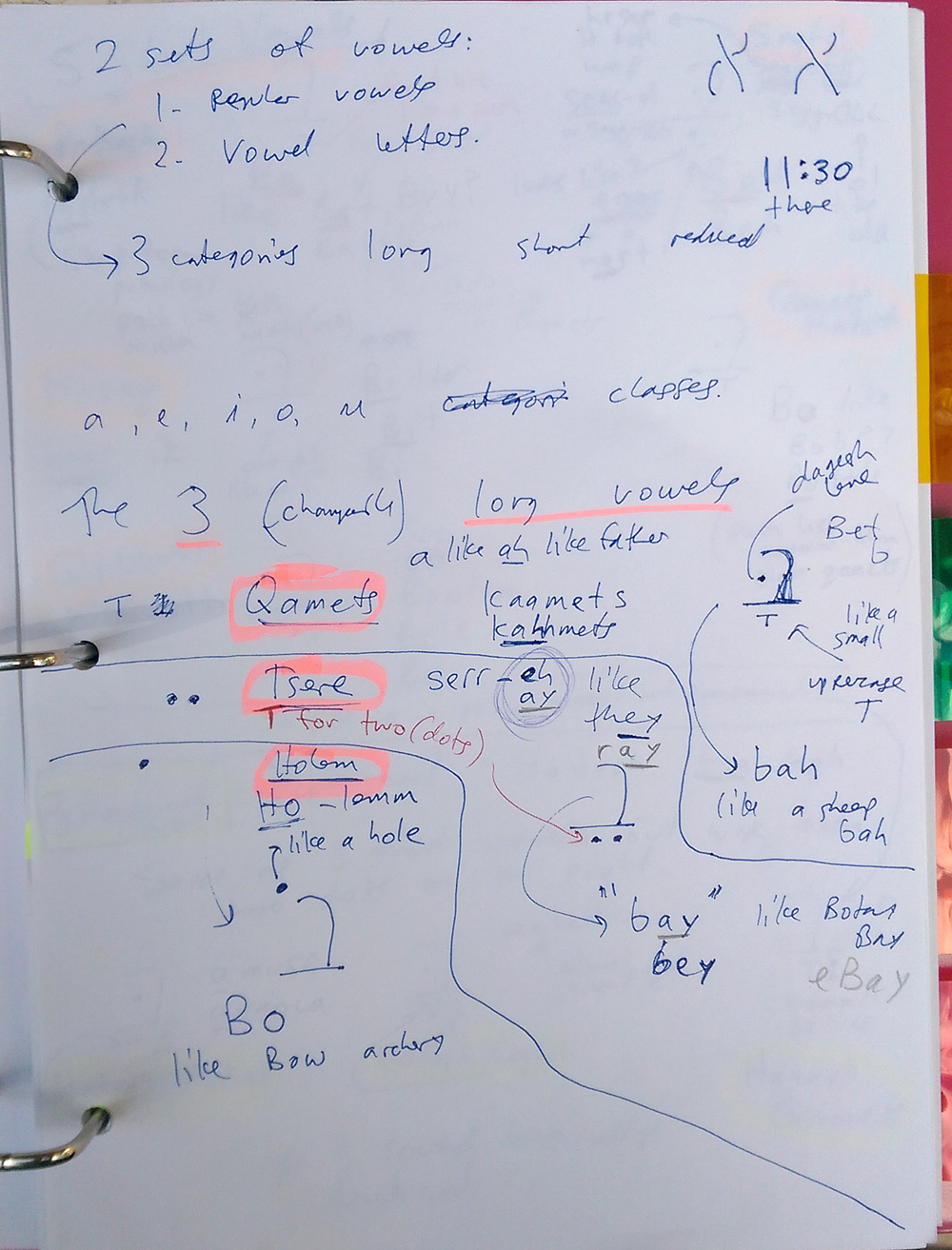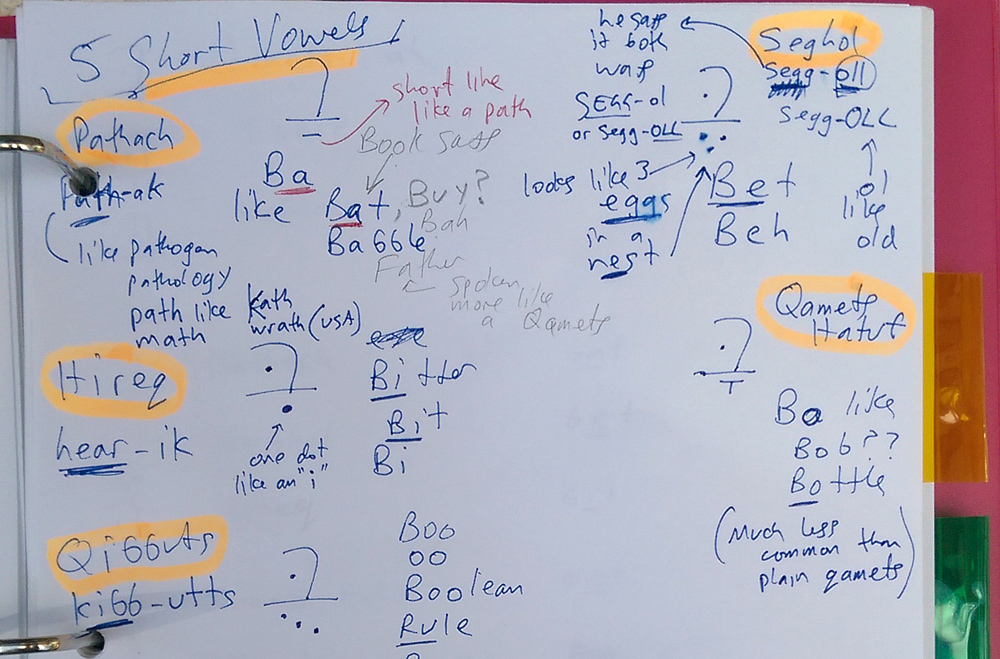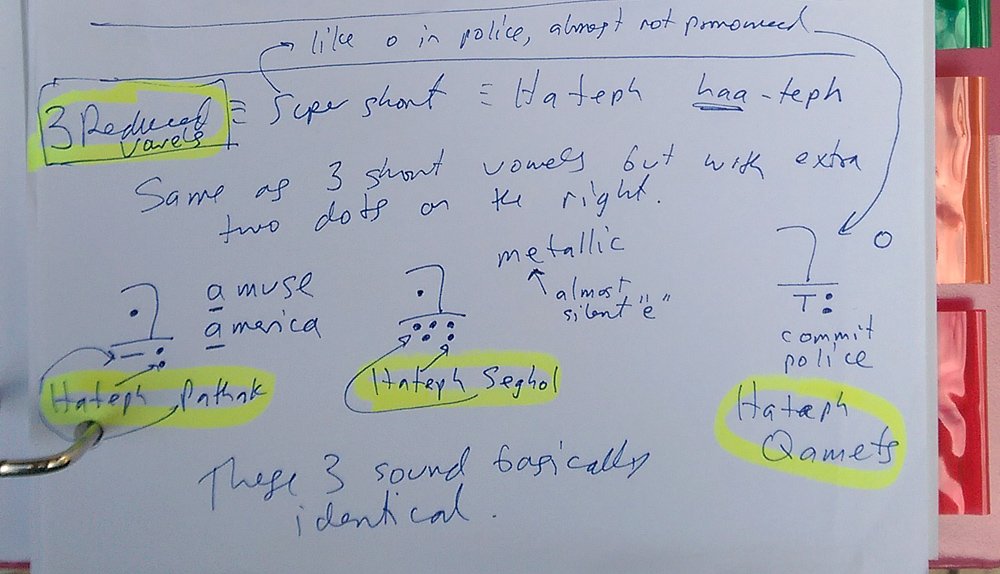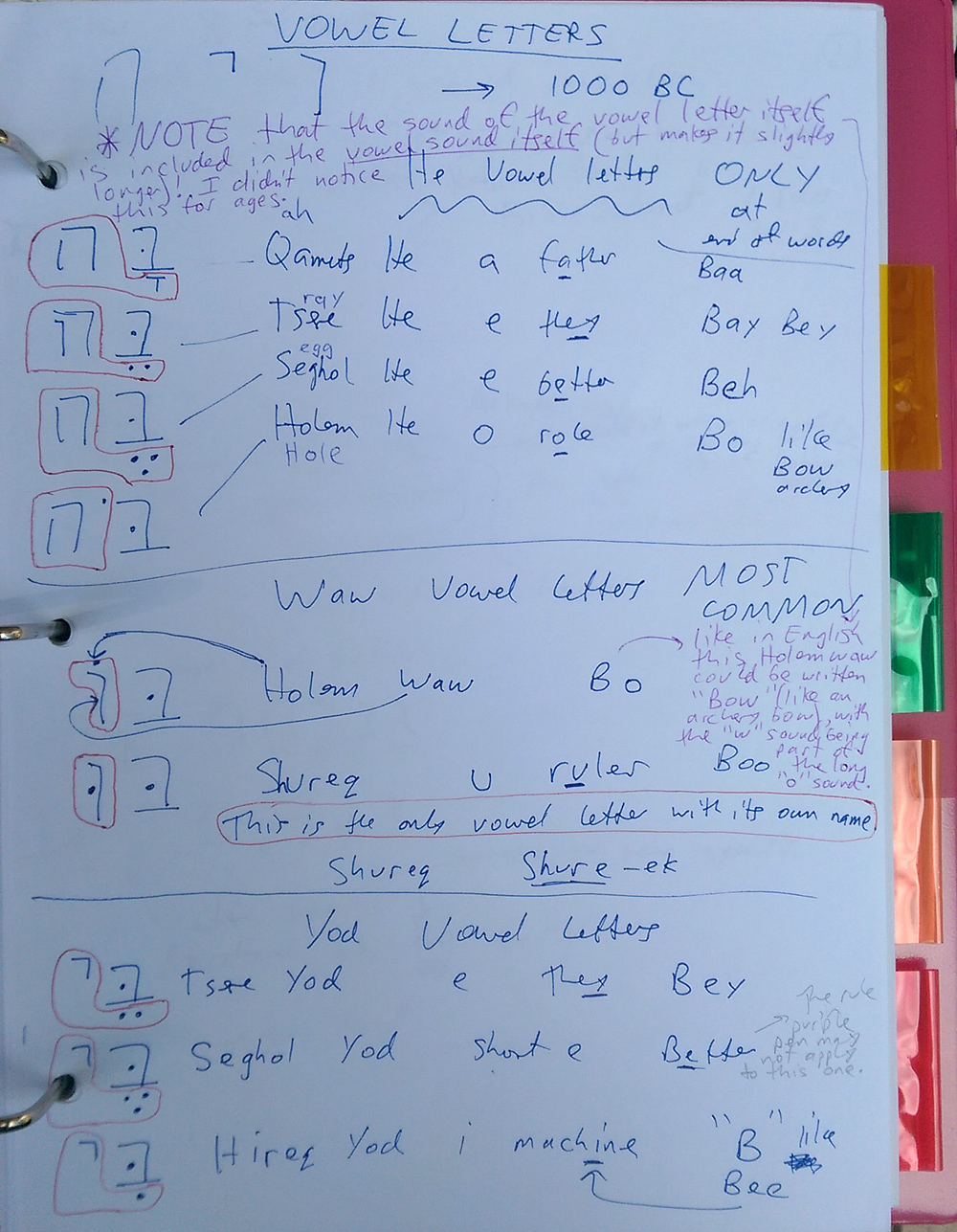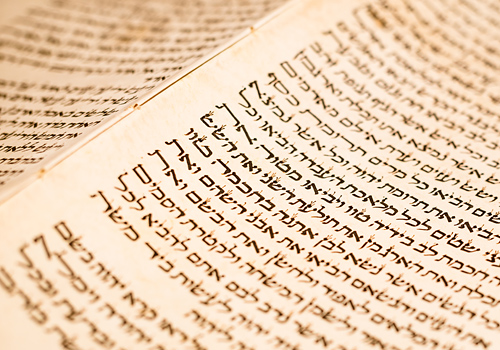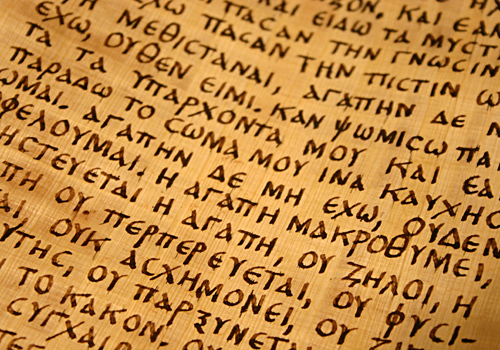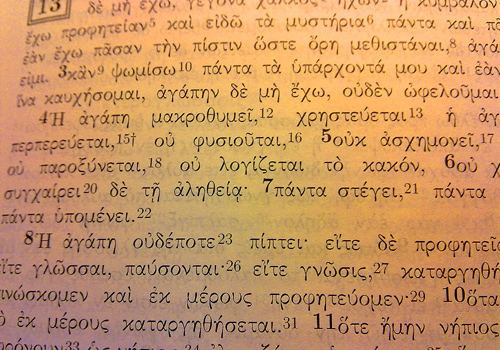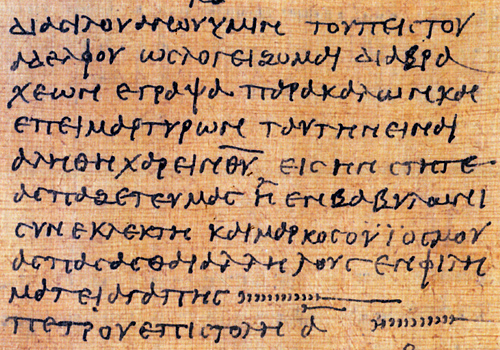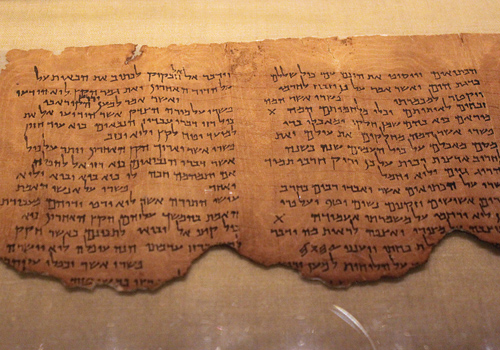Shortcuts for Beginning Biblical Hebrew
This page gives some shortcuts for beginning to learn Biblical Hebrew. Most of these are just things I thought up myself, to help me remember some of the words and grammar. I'm only new at this, so not everything is guaranteed to be 100% textbook-correct yet.
I'm studying beginning Biblical Hebrew at Morling College this year. So far this page will consist mainly of things featured in the book "Basics of Biblical Hebrew" by Gary D. Pratico and Miles V. Van Pelt. Though the same things are taught in most other Koine Greek courses, the order in which they are learned may vary.
This web page consists mainly of quick tips to aid learning, rather than full-length explanations of the concepts. Most of it probably won't make much sense unless you're studying the beginning stages of a Biblical Hebrew course.
See also: How I Began Learning the Biblical Languages, Shortcuts for Beginning Koine Greek.
![]() NEW: See also Memory Hints for Biblical Hebrew Words.
NEW: See also Memory Hints for Biblical Hebrew Words.
Hebrew Vocabulary Quizzes on Christ.net.au
Use these links for: Hebrew Word Quiz, Hebrew Meaning Quiz. Each one quizzes in a different direction, one from English to Hebrew and one from Hebrew to English.
Note that the easiest Hebrew quiz for beginners is the Word Quiz above with transliteration turned on (which is the default). For this, all you really need to know is the Hebrew Alphabet. If you turn off the transliteration, you need to know the meanings of the words. For the Meaning Quiz, having the transliteration on doesn't give the answers away nearly as much.
Note also that if you're using the textbook "Basics of Biblical Hebrew", I'll be adding options to choose questions from the vocabulary words from each chapter each week as I go through them this year. Currently I've done up to Chapter 17, and I should be adding about two chapters a week from now on. There are now extra options to select questions from the vocabulary words up to and including any chapter you select. These are all found using the drop down box before the blue "Load New Random Quiz" button (which defaults to "the 15 most popular words"). For the "Basics of Biblical Hebrew" chapters, select an option such as "BBH Chapter 3" and the quiz will be made of 10 random questions from only the vocabulary words in that chapter.
![]() UPDATE: Words from BBH in the Hebrew quizzes are currently up to Chapter 17.
UPDATE: Words from BBH in the Hebrew quizzes are currently up to Chapter 17.
Because the questions (and the multiple choice options) are generated randomly, you can do them many times over, and learn new and different words each time.
Online Resources for Biblical Hebrew
Free external links: Free Greek course online at Morling College in Sydney. The Master's Seminary Biblical Hebrew Full Video Course. Course Textbook and other PDFs (free). Other courses here.
Study Materials for Basics of Biblical Hebrew (2nd edition).
HOT:![]() BBH Vocabulary, all words by chapter in PDF format (from the page in the link above).
BBH Vocabulary, all words by chapter in PDF format (from the page in the link above).
BBH Vocabulary and paradigms in MP3 format (from the same page linked above).
![]() NEW: I'm using the music player Winamp and a couple of plugins. One called Loop Master allows you to loop on any section of a track, which is useful for repeating just a few words (e.g. from a vocabulary audio track) over and over. Despite being written in the year 2000, it's still working fine with the latest version of Winamp on Windows 10. Download link for Loop Master.
NEW: I'm using the music player Winamp and a couple of plugins. One called Loop Master allows you to loop on any section of a track, which is useful for repeating just a few words (e.g. from a vocabulary audio track) over and over. Despite being written in the year 2000, it's still working fine with the latest version of Winamp on Windows 10. Download link for Loop Master.
I also use the Winamp plugin called PaceMaker to slow the tracks down, which makes them easier to learn. It can go as slow as 50% of normal speed, but I usually only slow them down by 25% or else they sound too strange. PaceMaker has occasional "nag" popup boxes when you use the free version, which are a little annoying but not too bad. Download link for PaceMaker. I first used these for learning and teaching guitar, since changing the speed, and key of a song, and looping are very useful for that. There are many other programs and apps available which can also do these things.
To use the above plugins you first need the Winamp player itself. I'm using version 5.8 build 3660 from October 2018, which is the same version they still have as of March 2019. You can download Winamp here.
Hebrew Vowels
Originally the Hebrew letters were all consonants. (Except for Aleph and Ayin, which are silent letters in the modern system of learning Hebrew, and are used like place holders, around which vowel symbols can go. I'm not sure exactly what role they played in the original script that had no vowels.) The vowels were originally not written down at all — you just had to know what the words were meant to sound like.
Then much later, a system was developed to allow the vowels to be written as extra symbols around the existing consonants, and which allowed the words to be written with vowels without altering the spelling of the original biblical text (i.e. of the consonants).
The vowels are written as symbols (like lines or dots), usually below the consonants, and sometimes above and to the left. Note that most (but not all) of them are written as small symbols underneath the consonants. Also, almost always their sound is spoken after the consonant that they're written with.
Here are a few word associations that I made up to help me learn the Hebrew Vowels:
![]() NOTICE: There's a subtle mistake in the first three pictures from my handwritten notes below. The exact same mistake occurs twice in the first picture, once in the second (the 5 long vowels), once in the third (the 3 reduced vowels), and not at all in the final picture (the vowel letters). When I first noticed the mistake, I thought about fixing it in Photoshop — but it's much easier and quicker to write a few sentences of text — and you trying to find it can be a learning exercise in itself. The mistake doesn't affect anything about the vowels themselves, so it doesn't confuse any of the meanings on this page. As a clue, the mistake is related to the way I've written the Hebrew consonants, and has nothing to do with the vowels. See if you can spot what it is. The answer is given at the bottom of this page.
NOTICE: There's a subtle mistake in the first three pictures from my handwritten notes below. The exact same mistake occurs twice in the first picture, once in the second (the 5 long vowels), once in the third (the 3 reduced vowels), and not at all in the final picture (the vowel letters). When I first noticed the mistake, I thought about fixing it in Photoshop — but it's much easier and quicker to write a few sentences of text — and you trying to find it can be a learning exercise in itself. The mistake doesn't affect anything about the vowels themselves, so it doesn't confuse any of the meanings on this page. As a clue, the mistake is related to the way I've written the Hebrew consonants, and has nothing to do with the vowels. See if you can spot what it is. The answer is given at the bottom of this page.
The Three Long Vowels
In Biblical Hebrew the three long vowels are the Qamets, the Tsere, and the Holem.
Below is an image of the notes I made last year while watching the DVD for Chapter 2 of Basics of Biblical Hebrew. (Only Chapter 1 is free on YouTube).
Qamets sounds like the "ah" in "father". I didn't think up any trick to remember it, it was the first one I learned and I just learned it.
Tsere is pronounced like SERR-ay, with a silent T. It's called an "e" class vowel but it could sound like an English e or a. Its sound is the long "ay" sound like in obey, bay, ray, they, say. The trick I use to remember it is there are two dots and I memorised "T for two". Because it begins with a T.
Holem is unusual in that it's written above and to the left of the consonant. Imagine that the Holem dot is a "hole". The sound of the Holem is a long "oh" sound (the same as omega in Greek). Like in hole, row, mow, sew, throw.
The Five Short Vowels
The five short vowels in Biblical Hebrew are the Pathach, the Seghol, the Hireq, the Qamets Hatuf, and the Qibbuts.
The first three of these are seen very often. The Qamets Hatuf much less often, and the Qibbuts somewhat less often.
The Pathach is a short straight line so I imagine that it looks like a path. Officially, it's meant to sound like a short "a" like in "bat". However most people seem to pronounce it exactly like a Qamets — that is, like a long "a" as in "father". Which makes the memory aid of "path" work even better since then it looks like a path and also sounds like the "a" in "path".
The Seghol looks like three eggs in a nest. And it makes the short "e" sound like in the words egg and nest.
The Hireq is one small dot under the consonant. It sounds like a short "i", like the "i" in bit, sit, hit, rabbit, etc. Imagine the dot on an English "i", but since Hebrew is written backwards, the dot goes underneath the letter, instead of on top of it. You could take this even further and think of it as the missing dot from the Greek iota (which is written like a lower case English "i" but with no dot). So the dot ran away from above the "i" in Greek and is now found below the letters in Hebrew.
The Qamets Hatuf is confusing because it looks just like a Qamets but it sounds different, like a short "o" as in "bottle". Thankfully it is not often seen.
The Qibbuts is three dots in a descending straight line. It sounds like a double "o" in English, i.e. "oo" as in boo, loo, moo, kangaroo, and also like a "ue" in blue or true. The other way of writing the "oo" sound in Hebrew is called the Shureq, which is a vowel letter (see below), and this seems to be more common than the Qibbuts. I think that these can also sound like the "u" in rule, or the "oo" in boolean, which is a slightly different sound.
The Three Reduced Vowels
The three reduced vowels are the Hateph Pathach, Hateph Seghol, and Hateph Qamets. The way to learn these can also be "reduced", since they all basically sound exactly the same. Which is, they basically all sound like a very short "uh" sound.
Hateph Pathach is called an "a" class vowel. It sounds like the "a" in America, or amuse. That is, like a very short "uh".
Hateph Seghol is called an "e" class vowel. It sounds like the "e" in metallic (or the band "Metallica"). That is, like a very short "uh".
Hateph Qamets is called an "o" class vowel. It sounds like the "o" in police. That is, like a very short "uh".
So you can pretty much get away with thinking of these as all making the same sound.
The Vowel Letters
There are three types of vowel letters in Biblical Hebrew — based on He, Waw, and Yod.
The vowel letters can be thought of as a second system of Hebrew vowels, or another way of writing the same things. The Hebrew Bible / Old Testament / Tanakh uses both systems — sometimes the vowels are written with the vowel letters, and sometimes without them. The vowel letter system is older than the symbolic system as described above on this page. Originally the vowel letters only would have been added, without the vowel symbols (because the symbols hadn't been invented yet). In modern translations, both the symbols and the vowel letters are used.
While this sounds complicated, it actually makes it easier to read the Hebrew, not harder. (It probably makes it harder to write things in Hebrew — however most of the Hebrew that Christians use is translating from Hebrew to English, not the other way around, so this is not a problem).
When I first saw the vowel letters, I thought that it was going to be double the work of learning the Hebrew vowels. However, after a while I realised that the sounds of the consonants that go with the vowel letters pretty much just blend in with the vowel sound itself.
For example, think of the shortened English words for mother and father, "ma" and "pa". Now imagine they were spelt like "mah" and "pah". The h wouldn't really add anything to how the word sounds — because the "h" sound is already kind of there, as part of the vowel sound itself. That's how I came to think of the Hebrew vowel letters. In the previous example of "mah" and "pah", that would be a He (i.e. a "h" sound) class of vowel letter.
Consider the common English abbreviation for moustache, "mo". Now consider the word "mow" (as in to mow the lawn). Here the "w" is optional as the sound is the same in both cases. This is how I think of the Waw vowel letter. The "w" sound is kind of built into the tail end of the vowel sound itself.
For the Yod vowel letters, consider the English word "obey", here the "y" is explicitly written. This same "y" sound is kind of built into the end of the Tsere "ay" sound. It kind of works for the other two vowel letters, though perhaps less well for the Seghol Yod. The Hireq Yod can be thought of as sounding just the same as a Hireq, making the "ee" sound like in bee or the "i" in machine (which is the same sound, but in English it can be made with an "ee" or with an "i").
The answer to the question above about my mistake in the pictures is that I forgot to add the Daghesh Lene (the dot in the middle of the letter) to some of the Bet letters. But I still wrote the sounds as making a "b" sound, and not a "v" sound. The letter Bet without a Daghesh Lene (dot) sounds like an English "v", not a "b". I was thinking of them as all sounding like "b", I just forgot to write in the dot a few times.
(I also thought that I spelt "Daghesh" wrong in the first picture, as "Dagesh" — however looking online it seems that both spellings are acceptable).
Minimal/Slack Method for Learning Vowels
To learn the vowels as quickly as possible for reading the words, just learn Qamets בָ (looks like a tiny t-junction of a road, under the consonant) is "ah", Tsere בֵ is "ay" (and two dots, T for 2), Holem בֹ is a hole, "oh", and looks like a dot/hole to the top left of the consonant. That takes care of the three long ones, which are all seen very often.
Then Pathach בַ is a path, also "ah" (that's confusing since the book says its pronounced short "a" like apple, but it seems to always be actually pronounced the same as Qamets, "ah"). It looks like a path, i.e. a short straight line.
Seghol בֶ is three eggs in a nest, "e" like in egg and nest. Hireq בִ is a dot, like an i but under the letter (not on top like the English i, it's under and not above because Hebrew is read backwards), it sounds like "i" in bit.
Forget the Qamets Hatuf for now.
All three reduced vowels חֲ חֱ חֳ plus the Shewa בְ sound basically the same, a quick "uh". Note they all have the two vertical dots in them (the Shewa part). The Shewa can be silent or vocal, but you can learn that later — to start with just think of it as a quick pause and a syllable break.
The Shureq וּ (a waw with a dot in the middle) is an "oo" sound like shoo, or a "u" sound like rule (which is almost the same sound). The Qibbuts בֻ also makes this same "oo"/"u" sound, but it's seen less often.
For the vowel letters, just imagine the consonant is "kind of there", and say it like it would normally sound where it's written — as the end part of the vowel sound. (Which pretty much means you can either ignore, it or say, it and either way it will be basically the same).
If you only learn the above (i.e. from this section of the page only), it will be wrong some of the time (like if there's a Qamets Hatuf) but basically right most of the time. Once you know this much you can read most of the Hebrew words more-or-less correctly. After you know this much, it will be easier to then learn the rest of the vowels later, and learn them properly.
Super-Minimal/Slack Method
This is basically the same as above, but trimmed down even further.
Long
To learn the vowels quickly for reading the words, just learn Qamets בָ is "ah", Tsere בֵ is "ay" (and two dots, T for 2), Holem בֹ is a hole, "oh".
Short
Then Pathach בַ is a path, also "ah" (thats confusing since the book says its pronounced short "a" like apple, but it seems to always be actually pronounced the same as Qamets, "ah").
Seghol בֶ is eggs in a nest, "e" like in egg and nest. Hireq בִ is a dot like an i, and sounds like "i" in bit.
Forget the other short ones.
Reduced and Shewa
All three reduced ones חֲ חֱ חֳ plus the Shewa בְ sound the same, a quick "uh". Note they all have the two vertical dots.
Shureq
The Shureq וּ (a waw with a dot in the middle) is an "oo" sound like shoo.
Cover image by LaraP_photo / Shutterstock. Sea of Galilee, Israel. Landscape of North Galilee In early winter at Sunset.



